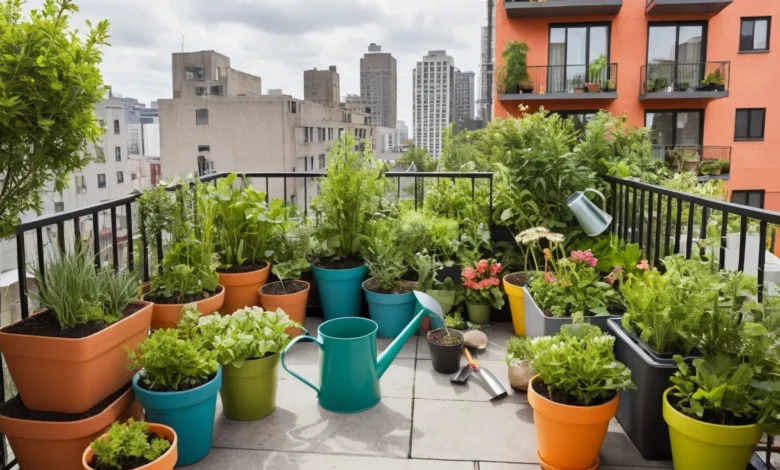Simple Gardening Tips for Urban Spaces: Transforming Your Concrete Jungle into a Green Oasis

Urban living often comes with limited space, making it challenging to cultivate a lush garden. However, with some creativity and planning, you can transform even the smallest balconies or window sills into vibrant green spaces. Here are some simple gardening tips tailored for urban environments to help you grow plants successfully and enjoy the beauty of nature right at home.
1. Start Small with Container Gardening
Container gardening is an excellent way to maximize limited space. Use pots, window boxes, or even recycled containers to grow your plants. Choose containers that have drainage holes to prevent overwatering. You can grow herbs, flowers, or even vegetables like tomatoes and peppers in containers. This method allows you to control the soil quality and makes it easier to relocate plants as needed.
2. Choose the Right Plants for Your Environment
Selecting the right plants is crucial for urban gardening. Consider your local climate, available sunlight, and the size of your space. Opt for plants that thrive in containers and can tolerate the urban heat. Herbs like basil, parsley, and mint are perfect for small spaces, while flowering plants like petunias and geraniums can add a splash of color. Additionally, look for native plants that are well-adapted to your local environment and require less maintenance.
3. Utilize Vertical Space
When space is limited, think vertically! Vertical gardening involves growing plants upward using trellises, wall planters, or hanging baskets. This approach not only saves ground space but also adds visual interest to your garden. Climbing plants like peas, cucumbers, and certain flowering vines can thrive in vertical gardens, giving you a bountiful harvest while making your space feel larger.
4. Maximize Sunlight Exposure
Urban environments can have limited sunlight due to buildings and other structures. Identify the sunniest spots in your home, such as south-facing windows or balconies that receive direct sunlight for several hours a day. Arrange your plants accordingly, placing sun-loving plants in the brightest areas and shade-tolerant plants in less sunny spots. Consider using reflective materials, like white walls or mirrors, to enhance light exposure.
5. Create a Microclimate
Urban areas often experience temperature variations that can be utilized to your advantage. Create a microclimate by grouping plants that share similar moisture and sunlight needs. You can also use larger plants to provide shade for smaller ones, helping to regulate temperature and humidity. Consider adding materials like stones or bricks, which absorb heat during the day and release it at night, creating a warmer environment for your plants.
6. Incorporate Edible Plants
One of the joys of urban gardening is the ability to grow your own food. Edible plants not only provide fresh produce but also enhance the aesthetics of your space. Herbs, salad greens, and dwarf varieties of fruits and vegetables can thrive in urban gardens. Choose compact varieties, such as cherry tomatoes or patio peppers, to maximize your harvest in small spaces.
7. Implement a Watering Schedule
Consistent watering is essential for healthy plants. In urban areas, container plants may dry out more quickly than those in the ground. Establish a watering schedule based on the needs of your plants, considering factors like temperature and humidity. Utilize self-watering pots or consider drip irrigation systems to simplify the process and ensure your plants receive adequate moisture.
8. Practice Composting
Even in urban spaces, you can practice composting to enrich your soil naturally. Use kitchen scraps like vegetable peels, coffee grounds, and eggshells to create a small compost bin. Composting not only reduces waste but also provides nutrient-rich soil for your plants, promoting healthy growth. Many cities offer composting programs, so check for local resources to assist you.
9. Join a Community Garden
If you lack space or resources, consider joining a community garden. These shared spaces allow urban dwellers to cultivate plants together, fostering a sense of community while learning from fellow gardeners. Community gardens often provide access to gardening tools, shared resources, and knowledge, making it easier for beginners to get started.
10. Stay Informed and Experiment
Gardening is an ongoing learning experience. Stay informed about urban gardening trends, seasonal planting guides, and pest management techniques. Experiment with different plants and techniques to discover what works best for your space. Don’t be afraid to make mistakes; each experience will enhance your skills and knowledge as a gardener.
Conclusion
Creating a garden in an urban space is entirely achievable with the right approach and mindset. By utilizing container gardening, maximizing sunlight, and incorporating vertical gardening techniques, you can cultivate a green oasis that enhances your living environment. Remember to choose suitable plants for your conditions, implement a consistent watering schedule, and stay informed to make the most of your urban gardening journey. With these simple tips, you can enjoy the numerous benefits of gardening while transforming your concrete surroundings into a vibrant, flourishing sanctuary.





